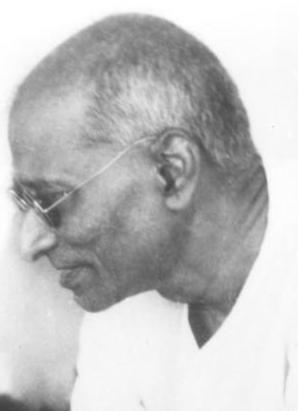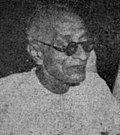Chakravarti Rajagopalachari
Chakravarti Rajagopalachari was an Indian politician, independence activist, lawyer, writer and statesman.[1] Rajagopalachari was the last Governor-General of India.[2] He also served as leader of the Indian National Congress, Chief Minister of Madras Presidency (present Tamil Nadu), Governor of West Bengal and Minister for Home Affairs of the Indian Union. Rajagopalachari founded a political party called Swatantra Party and was one of the first winners of India's highest civilian award, the Bharat Ratna. He was against the use of nuclear weapons and was a supporter of world peace. He was also called by the nickname 'Mango of Krishnagiri'.
Chakravarti Rajagopalachari | |
|---|---|
 C. Rajagopalachari | |
| Governor-General of India | |
| In office 21 June 1948 – 26 January 1950 | |
| Monarch | George VI |
| Prime Minister | Jawaharlal Nehru |
| Preceded by | The Earl Mountbatten of Burma |
| Succeeded by | Position abolished Dr. Rajendra Prasad as the President of India |
| 2nd Chief Minister of Madras | |
| In office 10 April 1952 – 13 April 1954 | |
| Governor | Sri Prakasa |
| Preceded by | P. S. Kumaraswamy Raja |
| Succeeded by | K. Kamaraj |
| Minister of Home Affairs | |
| In office 26 December 1950 – 25 October 1951 | |
| Prime Minister | Jawaharlal Nehru |
| Preceded by | Vallabhbhai Patel |
| Succeeded by | Kailash Nath Katju |
| Governor of West Bengal | |
| In office 15 August 1947 – 21 June 1948 | |
| Premier | Prafulla Chandra Ghosh Bidhan Chandra Roy |
| Preceded by | Frederick Burrows |
| Succeeded by | Kailash Nath Katju |
| 11th Chief Minister of Madras Presidency | |
| In office 14 July 1937 – 9 October 1939 | |
| Governor | The Lord Erskine |
| Preceded by | Kurma Venkata Reddy Naidu |
| Succeeded by | Tanguturi Prakasam |
| Minister of Education | |
| In office 2 September 1946 – 14 August 1947 | |
| Prime Minister | Jawaharlal Nehru |
| Succeeded by | Maulana Abul Kalam Azad |
| Personal details | |
| Born | 10 December 1878 Thorapalli, Madras Presidency, British India (now in Hosur Taluk, Krishnagiri District, Tamil Nadu, India) |
| Died | 25 December 1972 (aged 94) Madras, Tamil Nadu, India |
| Political party | Swatantra Party (1959–1972) |
| Other political affiliations | Indian National Congress (Before 1957) Indian National Democratic Congress (1957–1959) |
| Spouse(s) | Alamelu Mangalamma (1897–1916) |
| Children | C. R. Narasimhan C. R. Krishnaswamy C. R. Ramaswami Lakshmi Gandhi née C. R. Namagiri Ammal C. R. |
| Alma mater | Central College Presidency College, Madras |
| Profession | Lawyer Writer Statesman |
| Awards | |
Life
Rajagopalachari was born in the village of Thorapalli in the Krishnagiri district of the Madras Presidency (now the Krishnagiri district of Tamil Nadu).[3] He went to school at Central College, Bangalore, and Presidency College, Madras. After entering politics, he became a member and later President of the Salem municipality. He joined the Indian National Congress and was against the Rowlatt Act. He joined the Non-Cooperation movement, the Vaikom Satyagraha, and the Civil Disobedience movement. In 1930, Rajagopalachari risked going to prison when he led the Vedaranyam Salt Satyagraha in response to the Dandi March. In 1937, Rajagopalachari became Premier of the Madras Presidency and served until 1940, when he resigned because of Britain's declaration of war on Nazi Germany. After this, he supported co-operation with Britain's war effort and was against the Quit India Movement.
In 1946, Rajagopalachari became Minister of Industry, Supply, Education and Finance in the Interim Government of India. He then was the Governor of West Bengal from 1947 to 1948, Governor-General of India from 1948 to 1950, Home Minister of India from 1951 to 1952 and Chief Minister of Madras state (present Tamil Nadu) from 1952 to 1954. In 1959, he resigned from the Indian National Congress and founded the Swatantra Party, which stood against the Congress in the 1962, 1967 and 1972 elections. Rajagopalachari was an important person in setting up a united Anti-Congress front in Madras state under C. N. Annadurai, which swept the 1967 elections.
Chakravarti Rajagopalachari Media
Premier Rajagopalachari at a rally in Ootacamund, 1939.
Chakravarti with Mahatma Gandhi during the Gandhi-Jinnah talks, 1944. Gandhi described Chakravarti as his "keeper of my conscience"
During a 1948 tour of southern India, women in Mysore removing their gold necklaces and giving them to Rajagopalachari as a sign of honour.
Rajagopalachari with Defence Minister Baldev Singh and the chiefs of Staffs of Indian Armed Forces in 1948.
A portrait of C. Rajagopalachari at the Parliament House in New Delhi. Then PM Manmohan Singh, the Speaker, Lok Sabha, Meira Kumar, the chairman, BJP Parliamentary Party, Lal Krishna Advani and other dignitaries paid homage at the portrait of Rajagopalachari, on his Birth Anniversary on 10 December 2011.
References
- ↑ "C. Rajagopalachari: The icon India needs today". Archived from the original on 2016-12-10. Retrieved 2017-04-03.
- ↑ "How Rajendra Prasad (and not Rajaji) became India's first president". Archived from the original on 2016-11-30. Retrieved 2017-04-03.
- ↑ "C. Rajagopalachari Biography - Childhood, Life Achievements & Timeline". Archived from the original on 2017-08-16. Retrieved 2017-09-12.







